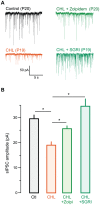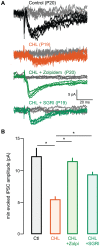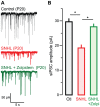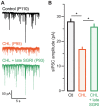Rescue of inhibitory synapse strength following developmental hearing loss
- PMID: 23326429
- PMCID: PMC3543446
- DOI: 10.1371/journal.pone.0053438
Rescue of inhibitory synapse strength following developmental hearing loss
Abstract
Inhibitory synapse dysfunction may contribute to many developmental brain disorders, including the secondary consequences of sensory deprivation. In fact, developmental hearing loss leads to a profound reduction in the strength of inhibitory postsynaptic currents (IPSCs) in the auditory cortex, and this deficit persists into adulthood. This finding is consistent with the general theory that the emergence of mature synaptic properties requires activity during development. Therefore, we tested the prediction that inhibitory strength can be restored following developmental hearing loss by boosting GABAergic transmission in vivo. Conductive or sensorineural hearing loss was induced surgically in gerbils prior to hearing onset and GABA agonists were then administered for one week. IPSCs were subsequently recorded from pyramidal neurons in a thalamocortical brain slice preparation. Administration of either a GABA(A) receptor a1 subunit specific agonist (zolpidem), or a selective GABA reuptake inhibitor (SGRI), rescued IPSC amplitude in hearing loss animals. Furthermore, this restoration persisted in adults, long after drug treatment ended. In contrast, a GABA(B) receptor agonist baclofen did not restore inhibitory strength. IPSCs could also be restored when SGRI administration began 3 weeks after sensory deprivation. Together, these results demonstrate long-lasting restoration of cortical inhibitory strength in the absence of normal experience. This suggests that in vivo GABA(A) receptor activation is sufficient to promote maturation, and this principle may extend to other developmental disorders associated with diminished inhibitory function.
Conflict of interest statement
Figures






Similar articles
-
Developmental hearing loss-induced perceptual deficits are rescued by genetic restoration of cortical inhibition.Proc Natl Acad Sci U S A. 2024 Jun 11;121(24):e2311570121. doi: 10.1073/pnas.2311570121. Epub 2024 Jun 3. Proc Natl Acad Sci U S A. 2024. PMID: 38830095 Free PMC article.
-
Preserving Inhibition during Developmental Hearing Loss Rescues Auditory Learning and Perception.J Neurosci. 2019 Oct 16;39(42):8347-8361. doi: 10.1523/JNEUROSCI.0749-19.2019. Epub 2019 Aug 26. J Neurosci. 2019. PMID: 31451577 Free PMC article.
-
Hearing loss prevents the maturation of GABAergic transmission in the auditory cortex.Cereb Cortex. 2008 Sep;18(9):2098-108. doi: 10.1093/cercor/bhm233. Epub 2008 Jan 24. Cereb Cortex. 2008. PMID: 18222937 Free PMC article.
-
Presynaptic GABA(B) receptors regulate experience-dependent development of inhibitory short-term plasticity.J Neurosci. 2010 Feb 17;30(7):2716-27. doi: 10.1523/JNEUROSCI.3903-09.2010. J Neurosci. 2010. PMID: 20164356 Free PMC article.
-
Developmental plasticity of auditory cortical inhibitory synapses.Hear Res. 2011 Sep;279(1-2):140-8. doi: 10.1016/j.heares.2011.03.015. Epub 2011 Apr 2. Hear Res. 2011. PMID: 21463668 Free PMC article. Review.
Cited by
-
Differential maturation of vesicular glutamate and GABA transporter expression in the mouse auditory forebrain during the first weeks of hearing.Brain Struct Funct. 2016 Jun;221(5):2619-73. doi: 10.1007/s00429-015-1062-3. Epub 2015 Jul 10. Brain Struct Funct. 2016. PMID: 26159773 Free PMC article.
-
Pharmacological modulation of Kv3.1 mitigates auditory midbrain temporal processing deficits following auditory nerve damage.Sci Rep. 2017 Dec 13;7(1):17496. doi: 10.1038/s41598-017-17406-x. Sci Rep. 2017. PMID: 29235497 Free PMC article.
-
Developmental hearing loss-induced perceptual deficits are rescued by genetic restoration of cortical inhibition.Proc Natl Acad Sci U S A. 2024 Jun 11;121(24):e2311570121. doi: 10.1073/pnas.2311570121. Epub 2024 Jun 3. Proc Natl Acad Sci U S A. 2024. PMID: 38830095 Free PMC article.
-
Development of Auditory Cortex Circuits.J Assoc Res Otolaryngol. 2021 Jun;22(3):237-259. doi: 10.1007/s10162-021-00794-3. Epub 2021 Apr 28. J Assoc Res Otolaryngol. 2021. PMID: 33909161 Free PMC article. Review.
-
Central plasticity and dysfunction elicited by aural deprivation in the critical period.Front Neural Circuits. 2015 Jun 2;9:26. doi: 10.3389/fncir.2015.00026. eCollection 2015. Front Neural Circuits. 2015. PMID: 26082685 Free PMC article. Review.
References
Publication types
MeSH terms
Substances
Grants and funding
LinkOut - more resources
Full Text Sources
Other Literature Sources

